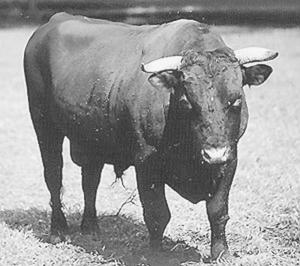2002 - Volume #26, Issue #6, Page #21
[ Sample Stories From This Issue | List of All Stories In This Issue | Print this story
| Read this issue]
America's "First Purebred Cattle" Making A Comeback
 |
According to most reports, they chose the medium-sized breed because it's very docile and had long served the people of Devonshire as oxen. They were also thought to be more intelligent than most of the other English breeds at the time.
John Wheelock, a Colchester, Vermont, dairy farmer, says the cattle that descended from that small herd eventually populated much of New England.
New Englanders depended heavily on their cattle, and, he says, for some 200 years, nearly all of their cattle were red. "The predominant breed was the Devon in the early years. Later, the colonists brought over Durhams (known in the U.S. as Milking Shorthorns). Not only did Devon cattle help clear and work the land, they later pulled carts and wagons as the settlers moved West," he adds.
The relative importance of Devon cattle to the Northeast is one reason Wheelock and other Devon enthusiasts organized the American Milking Devon Association in 1978. "The breed as it used to exist had dwindled to only a few animals," Wheelock says.
Part of the reason for that was that English breeders began selecting for beef. "Modern Devon bulls look more like big red locomotives," says Wheelock. "We felt we needed a breed association for our multipurpose cattle."
Most of the Milking Devon herds in the U.S. are small.Wheelock mingles his herd of 12 Devons with his better-milking Holsteins. Although the herds are small, there are now some 500 registered cattle in the herd book.
An American Milking Devon bull will top the scale at 1,600 to 1,800 lbs. Cows typically weigh 950 to 1,200 lbs. Birth weight for a calf is 75 to 100 lbs. "There are several distinct herd families in the U.S., so there is some variation in size, but for the most part these cattle are still about the same size, conformation and temperament as the ones that arrived here in 1623," he says.
Devon cattle are still being trained and used as oxen. "Nearly every county or community fair in this area has an oxen pull, and the favored breed for this is Devon," Wheelock says.
"They're far superior to horses for working in the woods or for doing field work. If you're out plowing and hit a rock, oxen stop and wait for you to decide what to do. Horses have been known to spook. Sometimes, people get hurt. Other times, the animals break their traces and run off. Oxen can be just as fast as horses at fieldwork, too."
As oxen, they're fast and sturdy, but fine boned. "Because their bones are smaller than those of similar sized breeds, muscle as a percentage of total weight is higher. They're slower growing than beef breeds today, so it takes longer to get them to market weight. Marbling of the meat is good, but the percentage of fat tends to be lower with Devons," Wheelock says.
He artificially inseminates his Devon cows using semen drawn mostly from his own bulls. "I only sell semen in special cases and rarely sell calves," he says.
"As a breed, Milking Devons in the modern world don't make a lot of economic sense," he says. "Still, they're good cattle to have around."
Contact: FARM SHOW Followup, John Wheelock, 359 Farnsworth Road, Colchester, Vt. 05446 (ph 802 878-4303; E-mail:ljwheelock@aol.com); or American Milking Devon Association, 135 Old Bay Road, Durham, N.H. 03855 (ph 603 859-6611; Website: www.milkingdevons.org; E-mail: mdevons@worldpath.net).

Click here to download page story appeared in.

Click here to read entire issue
To read the rest of this story, download this issue below or click here to register with your account number.




